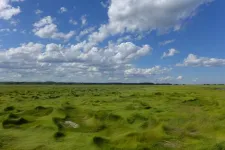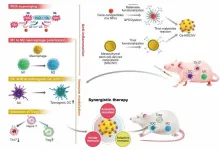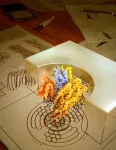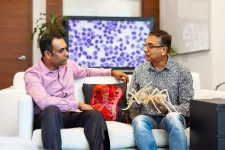(Press-News.org) WOODS HOLE, Mass.— At the surface, salt marshes and their windswept grasses can look deceptively simple. But those marshes are teeming with biodiversity, from the insects and migrating birds in the air all the way down to the microbes that live in the soil. Scientists from the Marine Biological Laboratory (MBL) have discovered that even among the sulfur-cycling microbes that are responsible for the “rotten egg gas” smell in salt marsh air, diversity extends all the way to genomes and even to individual nucleotides.
To study the relationship between saltmarsh cordgrasses and the sulfur-cycling microbes that live in the sediments around their roots, MBL scientists analyzed DNA sequenced datasets of microbes collected from salt marsh sites in Massachusetts and Alabama. This in-depth analysis of sulfur-cycling microbial diversity in salt marshes—from their entire genomes down to single nucleotides—was published October 26 in Applied and Environmental Microbiology.
In salt marshes, the sulfur cycle is closely linked with the carbon cycle, and healthy salt marshes store a very large amount of carbon in peat and associated soil minerals.
“We’ve known for decades how incredibly diverse microbial communities are out there in salt marshes,” said MBL Senior Scientist Zoe Cardon. “Thanks to this in-depth sequencing and analysis tools, we can now take a sample of salt marsh sediment and not only do the sequencing necessary to identify what microbes are there, but also construct in computers a representation of their individual genomes.”
These representations are called metagenome assembled genomes (MAGs), and they can be analyzed via computer without the need to culture the individual microbes in a petri dish. That’s important, since very few of the planet’s microbes have been cultured. In this study alone, 29 of the 38 isolated MAGs were from bacteria that had never been cultivated.
“We studied microbial communities in two ways: looking at differences at the single-nucleotide DNA sequence level—at the literal A-T-C-G scale—and comparing them at the pan-genome level. It was fascinating to develop this metagenomic pipeline to analyze this data,” said Sherlynette Pérez Castro, co-lead author of the paper. Pérez Castro was a postdoctoral researcher in the Cardon Lab at the MBL and has since moved on to a position at the University of Georgia.
Cardon described it as looking for a needle in a haystack full of needles. “But because of this relatively deep sequencing and these amazing analytical approaches, you can see things on a different level—instead of being a pile of needles, now you can see a red needle or a blue needle,” she said.
There are two different main types of sulfur-cycling bacteria—sulfate reducers, which help decompose organic matter but release a sulfide that is toxic to the plants, and sulfur oxidizers, which remove that toxic sulfide so support the productivity of the marsh plants. The microbes work together to support the health of these plants and this ecosystem.
“For all organisms, there is a specificity in the way the microorganisms and the host interact. We want to understand how the plants and the sulfur-cycling bacteria work together,” said Elena L. Peredo, co-lead author of the paper. Peredo is an adjunct scientist in the MBL Ecosystems Center and an assistant professor at the Rochester Institute of Technology.
For Peredo, one of the most exciting things was how closely related some of the microbes were to each other. “Two of the bacteria were almost identical until you got down to looking at specific metabolic pathways. Usually, in nature, when you have two organisms that are that closely related, one will outcompete the other,” she said. Much the same way lions and tigers aren’t found in the same ecosystem—there aren’t adequate resources to support them both.
“The microbes have different combinations of genes indicating slightly different variations on the themes of sulfate reduction and sulfur oxidation, and some of that variation may underlie why so many different kinds of sulfur-cycling microbes can all make a living in salt marsh sediment,” said Cardon.
A Diverse Team Effort
The work began as a pandemic project conducted by scientists in the MBL’s Ecosystem Center and Josephine Bay Paul Center for Comparative Molecular Biology and Evolution. The Gordon and Betty Moore Foundation had funded the group to study the symbiosis between the cordgrass and the sulfur-cycling microbes for the summer of 2020, but the pandemic shut down field work. So MBL’s personnel teamed up with scientists who already had very large DNA sequencing datasets from microbes in Massachusetts and Alabama salt marsh sediments, and the project was launched.
The initial data download and preliminary exploration were performed with the help of five summer students from multiple universities supported by two summer undergraduate research programs—the Metcalf Summer Undergraduate Research Program (SURF), and the Woods Hole Partnership Education Program (PEP).
“What started as a pandemic-era project that could be done while scientists worked from home, evolved into an exciting exploration of diverse sulfur-cycling microbes in salt marsh,” said Cardon. And in doing so, the group developed a whole new way to integrate metagenomic analyses from diverse scientific perspectives.
The MBL team working on the project was almost as diverse as the microbes themselves.
“A real strength of the MBL is that it’s a place where all different kinds of [scientists] can work together,” said Cardon. “On this paper we had people interested in the drivers of evolution, people interested in ecological function, people interested in plants —people coming at all of this from different perspectives but with that common interest.”
Citation:
Pérez Castro, S., E.L. Peredo, O.U. Mason, J. Vineis, J.L. Bowen, B. Mortazavi, A. Ganesh, S.E. Ruff, B.G. Paul, A.E. Giblin, Z.G. Cardon (2023) Diversity at single nucleotide to pangenome scales among sulfur cycling bacteria in salt marshes. Applied and Environmental Microbiology, DOI: 10.1128/aem.00988-23
END
Analysis finds diversity on the smallest scales in sulfur-cycling salt marsh microbes
MBL scientists analyzed sulfur-cycling microbial diversity in salt marshes—from their entire genomes down to single nucleotide pathways
2023-10-26
ELSE PRESS RELEASES FROM THIS DATE:
Stunting in infancy linked to differences in cognitive and brain function
2023-10-26
Children who are too short for their age can suffer reduced cognitive ability arising from differences in brain function as early as six months of age, according to new research from the University of East Anglia.
Researchers compared the ‘visual working memory’ – the memory capacity that holds visual cues for processing – in children who had stunted growth with those having typical growth.
Published today in the journal Nature Human Behaviour, the study found that the visual ...
New nanoparticles found to be effective for the treatment of rheumatoid arthritis
2023-10-26
A team of scientists led by KOO Sagang from the Seoul National University and Center for Nanoparticle Research within the Institue for Basic Science Center (IBS), in collaboration with researchers from Korea Institute of Science and Technology (KIST) and the Seoul National University, developed a new solution for the treatment of rheumatoid arthritis (RA).
RA is a chronic disease that, unfortunately, has no cure. The disease triggers a mix of troublesome symptoms like inflamed joints, harmful cytokines, and immune system imbalances, which work together to create a relentless cycle of worsening symptoms. While targeting ...
Admissions for bronchiolitis at children’s hospitals before and during the pandemic
2023-10-26
About The Study: The results of this study of 41 large U.S. children’s hospitals suggest that bronchiolitis hospitalizations decreased transiently and then increased markedly during the COVID-19 pandemic era. Patients admitted during the pandemic era were older and were more likely to be admitted to an intensive care unit. These findings suggest that bronchiolitis seasonality has not yet returned to pre-pandemic patterns, and hospitals should prepare for the possibility of atypical timing again in 2023.
Authors: Jonathan H. Pelletier, ...
Parent-perceived benefits and harms associated with internet use by adolescent offspring
2023-10-26
About The Study: This survey study of attitudes of 1,005 parents of children and adolescents ages 9 to 15 revealed both perceived benefits (e.g., family connectedness) and concerns (e.g., cyberbullying, addiction) of internet use. Twice as many parents reported specific concerns about internet addiction than substance addiction.
Authors: Michael Peter Milham, M.D., Ph.D., of the Child Mind Institute in New York, is the corresponding author.
To access the embargoed study: Visit our For The Media website at this link https://media.jamanetwork.com/
(doi:10.1001/jamanetworkopen.2023.39851
Editor’s ...
How adults understand what kids are saying
2023-10-26
CAMBRIDGE, MA -- When babies first begin to talk, their vocabulary is very limited. Often one of the first sounds they generate is “da,” which may refer to dad, a dog, a dot, or nothing at all.
How does an adult listener make sense of this limited verbal repertoire? A new study from MIT and Harvard University researchers has found that adults’ understanding of conversational context and knowledge of mispronunciations that children commonly make are critical to the ability to understand children’s early linguistic efforts.
Using ...
DNA Origami nanoturbine sets new horizon for nanomotors
2023-10-26
Nanoturbines: the heart of advancements
Flow-driven turbines lie at the heart of many revolutionary machines that have shaped our societies, from windmills to airplanes. Even life itself depends critically on turbines for fundamental processes, such as the FoF1-ATP synthase that produces fuels for biological cells and the bacterial flagella motor that propels bacteria. “Our nanoturbine has a 25-nanometer diameter rotor made from DNA material with blades configured in a right-handed or left-handed sense to control the direction of rotation. To operate, this structure is ...
NSF awards up to $21.4M for design of next-gen telescopes to capture earliest moments of universe
2023-10-26
The National Science Foundation has awarded $3.7 million to the University of Chicago for the first year of a grant that may provide up to $21.4 million for the final designs for a next-generation set of telescopes to map the light from the earliest moments of the universe—the Cosmic Microwave Background.
Led by the University of Chicago and Lawrence Berkeley National Laboratory, the collaboration seeks to build telescopes and infrastructure in both Antarctica and Chile to search for what are known as “primordial” gravitational waves—the vibrations from the Big Bang itself. It would also map the microwave light ...
Malaria protein discovery offers path for novel antimalarial intervention strategies
2023-10-26
The discovery of a malaria protein that helps the parasite grow inside red blood cells and plays a key regulatory role in the parasite’s immune evasion tactics could pave the way for new vaccines or therapeutics to combat the deadly infection.
The protein, known as PfAP2-P, was previously identified in a KAUST-led study that explored malarial genes and proteins displaying rhythmic 24-hour expression patterns — an adaptation that allows the parasite to synchronize its activities with those of the host during the human blood stage of its developmental cycle[1].
The expression levels of PfAP2-P seem to peak first around ...
Psoriasis not caused by spontaneous mutations in skin cells
2023-10-26
Psoriasis — a chronic skin condition — is not caused or spread by spontaneous genetic mutations in the skin, new research suggests.
The team, from the Wellcome Sanger Institute and collaborators, sequenced skin samples from 111 people with psoriasis. They didn’t find any mutated genes in the psoriatic patches that weren’t also mutated in the individual’s unaffected skin tissue.
The study, published today (26 October) in Nature Genetics, suggests that unlike other inflammatory diseases, such as inflammatory bowel disease or chronic liver disease, somatic mutations were not responsible for the start or spread of psoriasis.
Confirming that psoriasis ...
Marine protected areas and climate change
2023-10-26
An international team has developed the first comprehensive framework for designing networks of marine protected areas that can help vulnerable species survive as climate change drives habitat loss.
In a paper published Oct. 26 in One Earth, the researchers outlined guidelines for governments to provide long-distance larval drifters, like urchins and lobsters, as well as migratory species, like turtles and sharks, with protected stopovers along coastal corridors. Led by Stanford marine conservation scientist Nur Arafeh-Dalmau, the team included 50 scientists and practitioners ...
LAST 30 PRESS RELEASES:
The vast majority of US rivers lack any protections from human activities, new research finds
Ultrasound-responsive in situ antigen "nanocatchers" open a new paradigm for personalized tumor immunotherapy
Environmental “superbugs” in our rivers and soils: new one health review warns of growing antimicrobial resistance crisis
Triple threat in greenhouse farming: how heavy metals, microplastics, and antibiotic resistance genes unite to challenge sustainable food production
Earthworms turn manure into a powerful tool against antibiotic resistance
AI turns water into an early warning network for hidden biological pollutants
Hidden hotspots on “green” plastics: biodegradable and conventional plastics shape very different antibiotic resistance risks in river microbiomes
Engineered biochar enzyme system clears toxic phenolic acids and restores pepper seed germination in continuous cropping soils
Retail therapy fail? Online shopping linked to stress, says study
How well-meaning allies can increase stress for marginalized people
Commercially viable biomanufacturing: designer yeast turns sugar into lucrative chemical 3-HP
Control valve discovered in gut’s plumbing system
George Mason University leads phase 2 clinical trial for pill to help maintain weight loss after GLP-1s
Hop to it: research from Shedd Aquarium tracks conch movement to set new conservation guidance
Weight loss drugs and bariatric surgery improve the body’s fat ‘balance:’ study
The Age of Fishes began with mass death
TB harnesses part of immune defense system to cause infection
Important new source of oxidation in the atmosphere found
A tug-of-war explains a decades-old question about how bacteria swim
Strengthened immune defense against cancer
Engineering the development of the pancreas
The Journal of Nuclear Medicine ahead-of-print tip sheet: Jan. 9, 2026
Mount Sinai researchers help create largest immune cell atlas of bone marrow in multiple myeloma patients
Why it is so hard to get started on an unpleasant task: Scientists identify a “motivation brake”
Body composition changes after bariatric surgery or treatment with GLP-1 receptor agonists
Targeted regulation of abortion providers laws and pregnancies conceived through fertility treatment
Press registration is now open for the 2026 ACMG Annual Clinical Genetics Meeting
Understanding sex-based differences and the role of bone morphogenetic protein signaling in Alzheimer’s disease
Breakthrough in thin-film electrolytes pushes solid oxide fuel cells forward
Clues from the past reveal the West Antarctic Ice Sheet’s vulnerability to warming
[Press-News.org] Analysis finds diversity on the smallest scales in sulfur-cycling salt marsh microbesMBL scientists analyzed sulfur-cycling microbial diversity in salt marshes—from their entire genomes down to single nucleotide pathways






